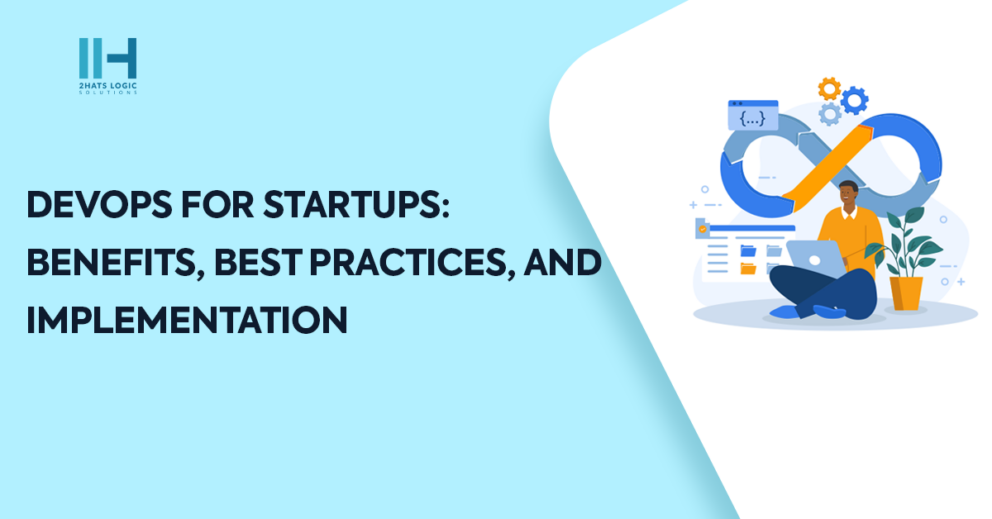Greetings! I'm Aneesh Sreedharan, CEO of 2Hats Logic Solutions. At 2Hats Logic Solutions, we are dedicated to providing technical expertise and resolving your concerns in the world of technology. Our blog page serves as a resource where we share insights and experiences, offering valuable perspectives on your queries.

Efficiency and agility are incredibly important for startups. In DevOps, there is a proper blending of development and operations with a smooth and automated process. This particularly addresses many challenges startups often encounter. This is beneficial because it breaks down barriers between development and operations teams. This in turn encourages teamwork and open communication. This collaboration results in quicker delivery of top-notch software. Eventually leading to happier customers who are more likely to stay loyal to your brand.
DevOps streamlines startup development, fostering collaboration, automating tasks, reducing errors. It integrates Ansible, GitHub, Docker, Jenkins, Bamboo for automation, version control, and continuous integration, enhancing software deployment.
In this blog post, we’ll explore the best practices that startups can adopt to increase the benefits of DevOps.
What is DevOps?

DevOps is a collaborative approach to software development that highlights communication, automation, and shared responsibility. It bridges the gap between development (Dev) and operations (Ops) teams that are traditionally separate entities in the software lifecycle. DevOps aims to simplify by working together and automating repetitive tasks for faster software delivery. This will lead to faster release cycles, improved software quality, and a more efficient development process.
Benefits of DevOps for Startups

DevOps offers several advantages for startups and equips them to be more agile and efficient in today’s competitive market. Here take a look at the major advantages:
- Better Communication and Collaboration
- Fewer Chances of Failure
- Time-Saving
- Lower Production Costs
- Faster Deployment
Better Communication and Collaboration
There will be clear communication channels to ensure everyone is on the same page. This is followed from initial planning to deployment. In the delivery of software, both of them work together as a team taking ownership of the entire process. There will be space for open communication that helps in quicker identification and resolution of issues
Fewer Chances of Failure
In the development phase, repetitive tests are run throughout to catch bugs early and prevent them from causing outages. DevOps goes for smaller and more frequent deployments instead of big and risky releases. This will allow for better and faster feedback. It will be also easy to identify issues before they become major problems. They consider infrastructure like code. This helps to maintain consistency and reduces the risk of configuration errors that lead to failures.
Time-Saving
In this tasks like testing and deployment are automated. This will free up development time for developers and operations personnel to focus on other important things. Automated testing and frequent deployment give better and quicker insights into the code changes. This will allow us to solve problems faster. When the repetitive tasks are reduced developers can focus on their core strengths.
Less Production Costs
The production cost will be reduced because of the automation feature. This feature eliminates the need for additional personnel to handle repetitive tasks. Using this it is easy to catch bugs early to reduce the need for costly bug fixes and rework later in development. Resources will be used efficiently to avoid unnecessary spending.
Faster Deployment
Manual deployments are error-prone and slow. But DevOps automates deployment that enables faster and more reliable releases. The risk factor is low as there are frequent deployments with smaller code changes. As there is proper streamlining between development and deployment it helps to remove bottlenecks that slow down the deployment process.
Best Practices for DevOps

- Collaborative culture
- Automate repetitive tasks
- Continuous Integration and deployment
- Continuous feedback mechanisms
- Constant learning and improvement
Collaborative culture
A culture of collaboration is a best practice in DevOps. This nature brings everyone across the development, operations and other departments together. There will be open communication, and knowledge sharing and everyone will work together. This prompts a unified approach to achieving common goals.
Automate repetitive tasks
Automation is the best practice in DevOps to automate repetitive and time-consuming tasks across the development and operations teams. Some of these include infrastructure provisioning, code configuration management, and deployment processes. Manual errors can be reduced with automation and the team will have more time for strategic work.
Continuous Integration and deployment
Implement CI/CD pipelines to automate the software delivery process. The process from code integration and testing to deployment and monitoring. This practice enables changes made to be validated quickly and to reduce errors. This enables faster delivery of new features and updates.
Continuous feedback mechanisms
Invest in continuous feedback mechanisms throughout the development and operation processes. Feedback can be gathered from end-users, operations teams and developers. This feedback can be further utilised to improve overall performance and operational efficiency.
Constant learning and improvement
DevOps is a continuous journey and it cannot be implemented just once. Develop a culture of continuous learning and experimentation within your organisation. Keep updated on the latest DevOps tools and other practices and adapt to your approach accordingly.
Essential DevOps Tools and Technologies
- Ansible
- Bamboo
- GitHub
- Docker
- Jenkins
DevOps relies on a combination of tools and technologies to automate processes, streamline collaboration, and ensure efficient software delivery. Here’s a breakdown of the mentioned tools and their purposes in the DevOps landscape:
Ansible
Ansible is an open-source configuration management tool that automates IT tasks using code. It can handle provisioning, configuration management, application deployment, and orchestration of your infrastructure. Ansible defines the desired state of your infrastructure using playbooks written in YAML, a human-readable language. This approach minimizes manual errors, enforces compliance with defined standards, and simplifies rollbacks through code-driven automation. Ansible also facilitates consistent configurations across various environments like development, testing, and production.
Bamboo
Bamboo is a CI server that automates the build, testing, and packaging of software applications. It integrates with source code repositories (like Git) and triggers builds whenever code changes are committed. This tool comes under the category of a continuous integration server. This tool enables developers to detect bugs and integration issues easily through automated testing. Time-saving tool to streamline the building and testing process.
GitHub
GitHub is a popular version control system that allows developers to track code changes, collaborate on projects, and revert to previous versions if required. It provides a central repository for storing and managing code versions. This is an important tool to facilitate
collaboration among developers by allowing them to track code changes, merge branches, and resolve conflicts. Allows developers to revert to previous code versions if necessary as it enables version control.
Docker
Docker is a containerization platform that allows you to package applications with all their dependencies into standardized units called containers. These containers are lightweight and portable, enabling them to run consistently across different environments. This enables
faster development and deployment cycles by isolating applications in containers. This promotes efficient resource utilization by allowing multiple containers to share the same operating system.
Jenkins
Jenkins is an open-source automation server for making software development life cycles easier by automation tasks like building, testing, and deploying code. Continuous integration and delivery are thus done with an emphasis on automation. It is like an assembly line for your software: Jenkins automates the steps and lets developers focus on their code. Jenkins has a vast library of plugins, for a wide range of development tools, creating a smooth and efficient workflow.
Why DevOps Implementation is necessary?
DevOps simplifies development, unites the team, and accelerates the delivery of software, a prerequisite for a startup to be effective and scalable. This helps to enhance efficiency, minimise errors, and speed up the time to market software solutions.
A startup’s DevOps implementation must strike a strategic balance between security, optimization, and usability. Infrastructure design must emphasize robust security features to prevent host environments from being compromised. This is a major problem because startups don’t usually have dedicated security teams for their resources.
The right DevOps tools are also important to minimize operations and management overhead since poor planning often leads to ineffective workflow and a higher cost. With these in mind, startups can build up a robust DevOps framework to accelerate development cycles and scale digital solutions.
DevOps Implementation plan
- Assess and Plan
- Foundation Building
- Continuous Delivery and Optimization
The implementation of DevOps can be divided into three phases and let’s take a look at the implementation plan:
Phase 1: Assess and Plan
In the first phase, you have to clearly define what you want to achieve with DevOps it can be faster deployments or better collaboration. Then you have to evaluate the existing processes and look for areas of improvement. Try to promote collaboration between Dev and Ops teams. Develop a culture of shared responsibility and continuous improvement. Find out the best DevOps tools that go in line with your needs and goals
Phase 2: Foundation Building
In phase 2 implement a centralized version control system to manage code effectively.
Version control tool is discussed above checkout and find the right one for your organization.
To automate infrastructure provisioning and configuration introduce IaC tools. Set up a CI pipeline using tools like Jenkins to automate building, testing, and integration of code changes. Establish feedback loops to ensure continuous improvement.
Phase 3: Continuous Delivery and Optimization
In the phase 3, extend your CI pipeline to include automated deployments using CD tools. Aim for frequent and reliable deployments. Security is another major factor.Integrate security practices throughout the development lifecycle to ensure secure deployments. Throughout the phase continuously monitor and optimize application performance for a smooth user experience. Use data and metrics to refine your DevOps practices for continuous improvement.
Conclusion
DevOps is a catalyst for startups, which actually brings together the best collaborations, effectiveness, and software delivery. It streamlines its processes through the best practices of using tools such as Ansible, GitHub, Docker, Jenkins, and Bamboo. Tasks are automated to accelerate deployment. This all needs to be put down on paper—much like any effective DevOps strategy—so that communication is at its best, efficiency is ensured, and speed is achieved in cycles. DevOps has to be tuned to strike a balance between security and efficiency to be successful. For any assistance or expert guidance on DevOps services, feel free to reach out for a smoother implementation and enhanced outcomes.
FAQ
What is DevOps in simple terms?
DevOps is a set of practices that combines software development (Dev) and IT operations (Ops) to shorten the systems development life cycle and provide continuous delivery of high-quality software.
What is DevOps used for?
DevOps is used to improve collaboration between development and operations teams, automate processes, increase deployment frequency, enhance software quality, and achieve faster time-to-market for applications and services.
What are the DevOps tools for beginners?
Some popular DevOps tools for beginners include Git for version control, Jenkins for continuous integration, Docker for containerization, Ansible for configuration management, and Prometheus for monitoring, among others.
What are the benefits of DevOps automation?
The benefits of DevOps automation include standardization of processes that contributes to the improvement of reliability. Enhanced collaboration among teams, improved scalability, and the best utilization of resources contribute to a faster development cycle and, therefore, higher-quality software deployment.

Related Articles





